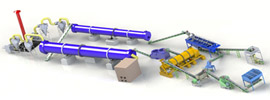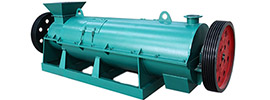The particle strength produced by roller extrusion granulators typically reaches 15–25 N, with some applications exceeding 30 N, depending on factors such as equipment pressure, die design, material properties, and process parameters. Below is a detailed analysis of granulation strength:
I. Key Indicators of Granulation Strength
Roller extrusion granulators compress dry powder materials into granules through high-pressure extrusion. The strength of these granules directly impacts their performance in transportation, storage, and end-use applications. Particle strength is commonly measured by crushing resistance (unit: N), with quality granules required to meet the following standards:
- Transportation Requirements: The breakage rate during long-distance transport should remain below 3%, necessitating a particle strength of at least 15 N.
- Storage Requirements: Granules stored at room temperature for six months should exhibit a caking rate below 5%, requiring dense, high-hardness structures.
- Usage Requirements: Granules must remain intact during fertilization or industrial applications to prevent pulverization or caking.
II. Key Factors Influencing Granulation Strength
- Equipment Pressure
- High-Pressure Systems: Hydraulic systems deliver extrusion pressures of 15–30 MPa, increasing material density from 0.6 g/cm³ to 1.2–1.5 g/cm³ and significantly enhancing particle strength.
- Pressure Adjustment: Pressure settings must align with material properties (e.g., 25–30 MPa for slag powder, 15–20 MPa for organic fertilizer powder) to avoid overly hard or brittle granules.
- Die Design
- Aperture and Thickness: Smaller die apertures (e.g., 4 mm) produce smaller granules with higher pressure per unit area, increasing strength by approximately 30% compared to 8 mm apertures. Thickness is maintained at 5–10 mm to ensure hardness and transport stability.
- Material and Precision: Die plates made of wear-resistant alloy steel (e.g., Cr12MoV) with surface quenching (hardness ≥ HRC58) resist deformation during prolonged use, ensuring consistent granule dimensions.
- Material Properties
- Particle Size Distribution: Fine particles (<0.5 mm) accounting for 40–60% of the feedstock fill voids more effectively, enhancing strength.
- Moisture Control: Optimal moisture levels (10–20%) balance flowability and bonding; excessively low moisture causes poor feeding, while high moisture leads to sticking or voids.
- Chemical Composition: Materials containing adhesive components (e.g., starch, protein) exhibit stronger intermolecular forces, yielding higher-strength granules. Brittle materials require binders.
- Process Parameters
- Feeding Rate: Consistent feeding (e.g., via screw feeders) ensures uniform material distribution, preventing localized pressure imbalances.
- Extrusion Time: Roller speed affects dwell time, requiring a balance between production efficiency and granule strength (e.g., reduced speed for higher strength requirements).
- Post-Processing: Drying (temperature/time control), cooling, and screening further enhance granule stability.
III. Strength Performance in Practical Applications
- Organic Fertilizer Granules
- Parameters: 20 MPa pressure, 6 mm die aperture, 15% moisture content.
- Performance: Hardness 22 N, density 1.3 g/cm³, 2.5% breakage rate after 500 km transport, and 3% caking rate after six months of storage.
- User Feedback: Durable for transport and uniform for spreading, suitable for large-scale farming.
- Compound Fertilizer Granules
- Parameters: 25 MPa pressure, 5 mm die aperture, 12% moisture content.
- Performance: Hardness 25 N, density 1.5 g/cm³, 2.8% breakage rate after 800 km transport, and 4% caking rate after eight months of storage.
- User Feedback: No caking in winter, praised by farmers for "storage durability and ease of application."
- Biomass Fuel Granules
- Parameters: 30 MPa pressure, 8 mm die aperture, 10% moisture content.
- Performance: Hardness 28 N, density 1.4 g/cm³, no deformation under 3-meter stacking, and 15% higher combustion efficiency than loose materials.
- User Feedback: Transport-resistant and fully combustible, reducing fuel costs.
 Send us a Email
Send us a Email Wulong Industrial Cluster
Wulong Industrial Cluster Have any question?
Have any question?



















